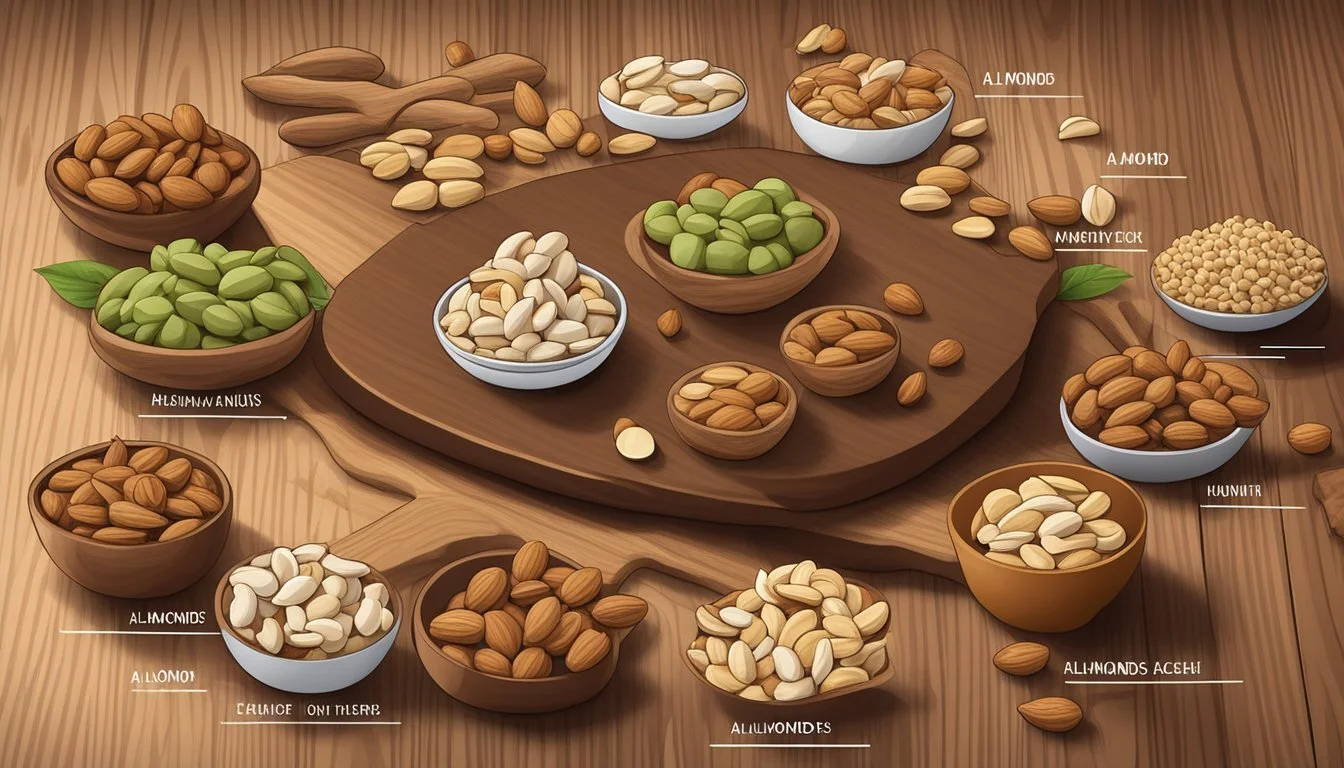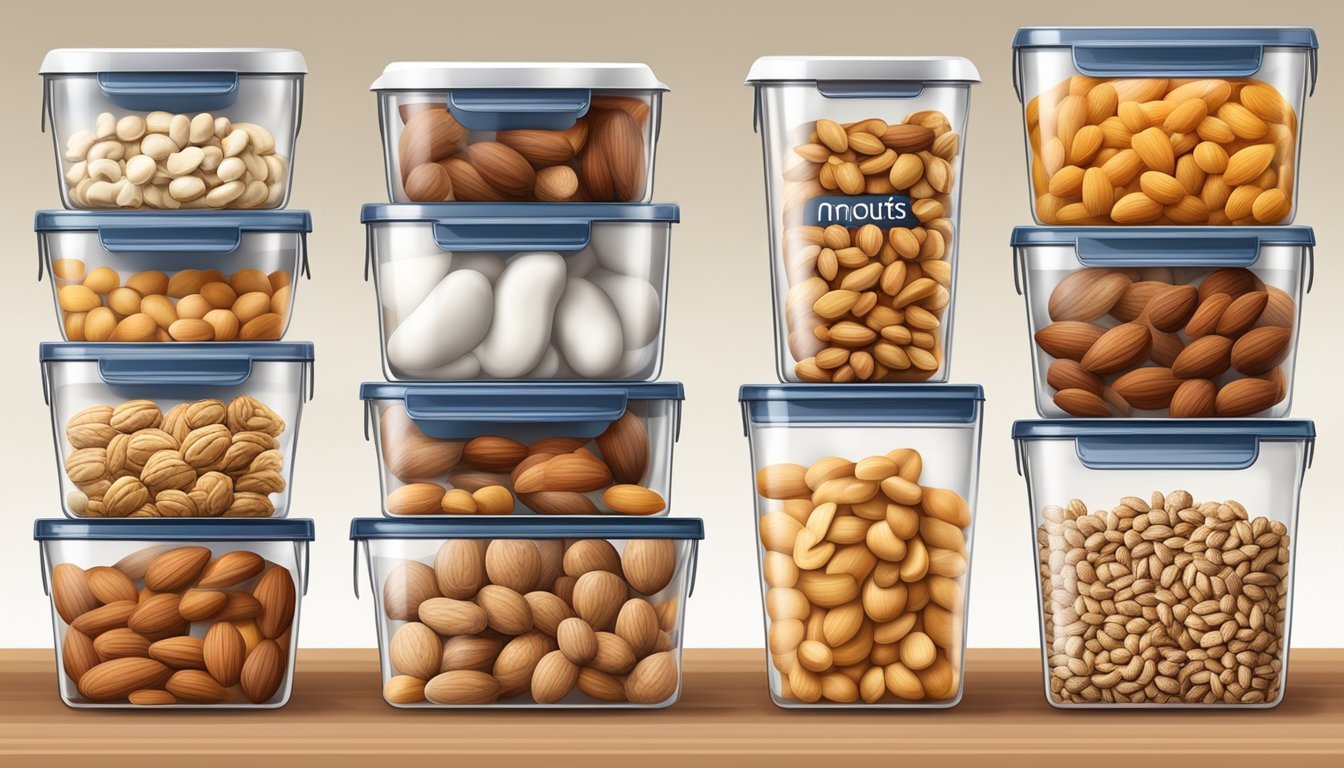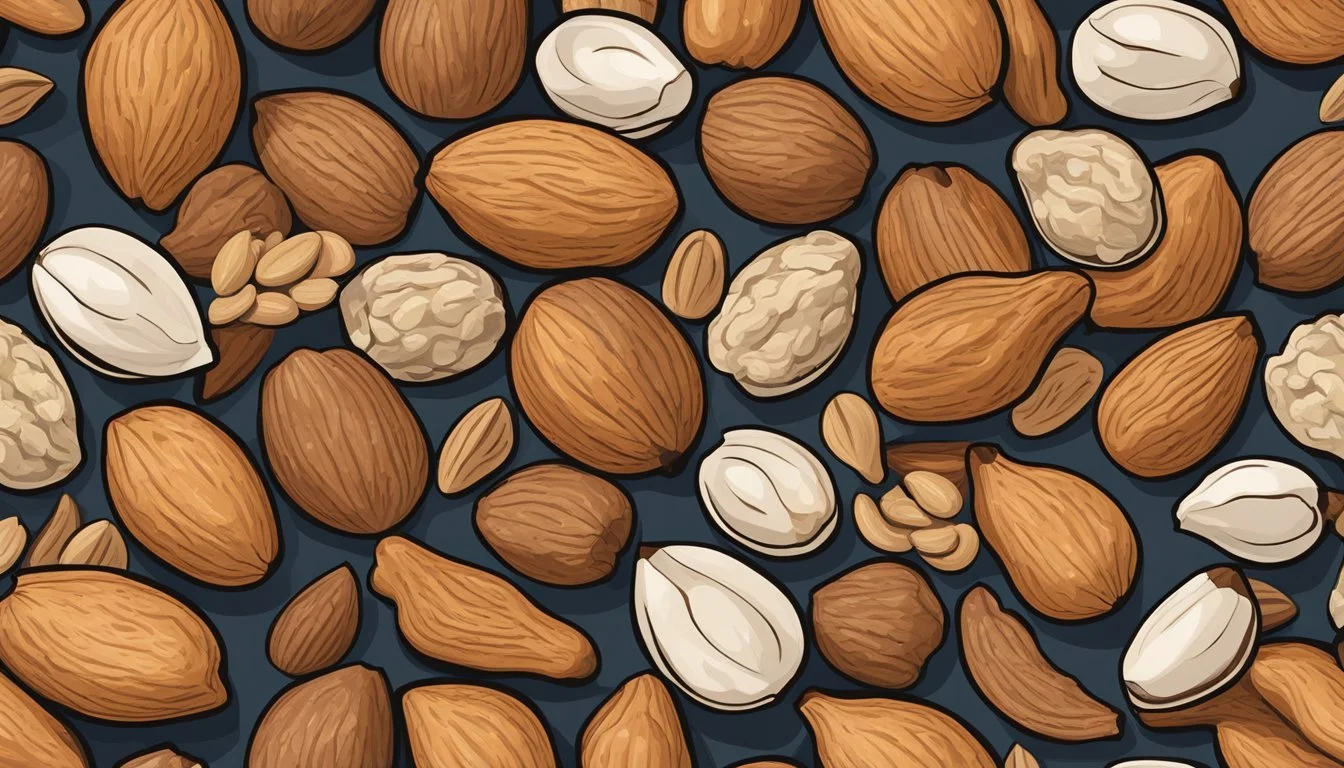How Long Does Nuts Last?
Shelf Life of Almonds, Walnuts, Cashews Explained
Nuts such as almonds, walnuts, and cashews are prized for their taste, nutritional value, and versatility in the culinary world. However, their shelf life can vary considerably based on factors such as the nut type, storage conditions, and whether they are shelled or unshelled. Understanding the longevity of these nuts is essential for maintaining their freshness and ensuring that they are consumed when they are at their best.
Generally, almonds, walnuts, and cashews kept in a cool, dry place away from direct sunlight retain their quality for a period of time specific to each type. For example, almonds have a longer shelf life compared to cashews due to their lower oil content. The freshness of these nuts is preserved far longer when they are stored in a refrigerator or freezer. Here they may last for several months to over a year depending on the nut, with unshelled versions lasting longer than their shelled counterparts.
Even though nuts have a relatively long shelf life, they are still susceptible to spoilage, primarily through rancidity or the development of mold. This process is accelerated by exposure to heat, moisture, and air. To prevent such spoilage and ensure maximum preservation, nuts should be stored in airtight containers. This helps maintain quality and prolongs the period during which they can be enjoyed at their freshest.
Types of Nuts and Their Nutritional Profile
Nuts are a powerhouse of nutrition, each type offering a unique profile of proteins, fats, vitamins, and minerals. Below is an overview of the nutritional value of various popular nuts.
Almonds
Almonds are rich in vitamin E and calcium, and provide a good amount of fiber and protein. They are also high in unsaturated fats, which are beneficial for heart health.
Walnuts
Walnuts are well-known for their high omega-3 fatty acid content, particularly alpha-linolenic acid (ALA), and are a great source of fiber and antioxidants.
Cashews
Cashews are a good protein source and also provide a notable amount of unsaturated fats. They contain essential minerals like magnesium and zinc.
Pistachios
Pistachios are not only high in fiber but also have more protein than other nuts. They also boast antioxidants and unsaturated fatty acids.
Pine Nuts
Pine nuts offer an excellent nutritional profile, with a high calorie count and a substantial amount of carbohydrates. They are often used in making pesto sauce.
Pecans
Pecans are rich in B vitamins and house a good balance of fiber and protein. They are also high in antioxidants, contributing to overall health.
Hazelnuts
Hazelnuts are another good source of vitamin E and fiber. They contain fatty acids that are essential for maintaining a healthy heart.
Peanuts
Although technically legumes, peanuts are comparable in nutritional value to tree nuts and are high in protein and B vitamins. They also have a rich unsaturated fatty acid profile.
Macadamia Nuts
Macadamia nuts are higher in monounsaturated fats and lower in omega-6 fatty acids, offering a unique fat composition among nuts. They also provide fiber, protein, and are considered a superfood.
Chestnuts
Chestnuts stand out with a lower fat content and higher carbohydrates. They are also a good source of vitamins such as vitamin C, and trace minerals.
Factors Affecting Nut Freshness and Shelf Life
The shelf life of nuts such as almonds, walnuts, and cashews is impacted by several key factors. These can influence their freshness and propensity toward rancidity. Understanding these elements is essential in prolonging the usability of nuts.
Moisture
Nuts high in moisture are more prone to bacterial growth and spoilage. Storage in low humidity environments helps to maintain their freshness. When nuts absorb moisture from the air, their texture and taste can be adversely affected, leading to faster deterioration.
Heat
Exposure to heat can expedite the rancidity of nuts due to the breakdown of their natural oils. Storing nuts in a cool environment helps prevent the unsaturated fats within them from becoming rancid. Room temperature or cooler is generally recommended.
Light
Nuts can be sensitive to oxidation when exposed to light, which can lead to deterioration in both flavor and nutritional value. To prevent this, nuts should be stored in dark conditions, away from direct sunlight or bright indoor lighting.
Air Exposure
Exposure to air, especially oxygen, can promote the oxidation of nuts, causing them to become rancid. Nuts should be kept in air-tight containers to minimize air exposure. Additionally, removing as much air as possible from the container before sealing can prolong freshness.
Storage Conditions
The overall storage conditions play a significant role in the longevity of nuts. Ideal storage includes air-tight containers, placed in a dark, cool, and dry location. Odors in the storage environment can be absorbed by nuts, so it's important to store them away from strong-smelling substances. Regularly check for signs of rancidity or spoilage, which can include an off smell and bitter taste.
Proper Storage Techniques for Nuts
Proper storage is critical for maintaining the freshness and extending the shelf life of nuts, including almonds, walnuts, and cashews. The three main storage techniques involve room temperature, refrigeration, and freezing, each suited to different durations of storage.
At Room Temperature
Storing nuts at room temperature is convenient, but it requires attention to detail to prevent spoilage. Nuts should be kept in a cool, dry place such as a pantry or kitchen cupboard. Roasted nuts may last up to 9 months when stored in a sealed bag or airtight container. Raw nuts, being more delicate, can maintain quality for 6 to 9 months if the environment is stable and moisture-free.
Almonds: Up to 9 months
Walnuts: 6- 12 months
Cashews: Up to 6 months
In the Refrigerator
Refrigeration prolongs the life of nuts by slowing down the oils' oxidation. When refrigerated in airtight containers or sealed bags, nuts can last significantly longer. Roasted nuts have a refrigerator shelf life of over 1 year, while raw nuts—especially more delicate varieties—benefit from refrigeration, with their shelf life extending to around 6 to 12 months.
Almonds: 9-12 months
Walnuts: 6-12 months
Cashews: Up to 6 months
Freezing Nuts for Long-Term Storage
For extended preservation, freezing nuts is the most effective method. Both roasted and raw nuts can be stored in the freezer. Place nuts in a sealed bag or air-tight container to avoid freezer burn. Labeling with the date of storage is important for proper rotation. Frozen nuts can be kept for several years without significant loss of quality.
Almonds: More than 1 year
Walnuts: More than 1 year
Cashews: More than 1 year
Storing nuts in bulk bins should be avoided unless they are used quickly, as the exposure to air, humidity, and varying temperatures can hasten spoilage. When properly stored, nuts not only last longer but also retain their crunch, flavor, and nutritional value.
Identifying and Preventing Spoilage
When storing nuts like almonds, walnuts, and cashews, it is imperative to recognize the signs of spoilage and understand how to inhibit mold and bacteria growth to maintain their quality and safety.
Signs of Rancidity
Nuts become rancid due to the oxidation of their natural oils, leading to an unpleasant taste and odor. Key indicators include:
Smell: A sharp, bitter odor compared to the nut's original, pleasant aroma.
Taste: An off, bitter flavor that deviates from the nut's inherent rich and creamy profile.
Color: Dull appearance or discoloration, though this may be less noticeable compared to other signs.
Rancidity not only affects the flavor but also the nutritional value, making prompt identification crucial.
Preventing Mold and Bacteria
To maintain the quality and longevity of nuts, proper storage methods are crucial:
Control Humidity: Store nuts in a cool, dry area to reduce the risk of mold. The refrigerator or freezer can provide an optimal environment.
Airtight Containers: Use containers that seal out moisture and air.
Clean Storage: Ensure that the storage area is clean and free from potential contaminants.
Check the Label: Pay attention to "best by" dates as a guideline for peak quality.
Routine Inspection: Regularly check for signs of spoilage such as mold growth or unexpected odors.
By following these storage recommendations, one can effectively diminish the potential for spoilage and ensure the nuts remain fresh for consumption.
Understanding Nut Shelf Life
When considering the shelf life of nuts, factors such as whether they are shelled or unshelled, roasted or raw, greatly impact their freshness and storage duration. Proper storage can extend their quality and useful life.
Shelled vs Unshelled Nuts
Shelled nuts, due to their exposed surface, generally have a shorter shelf life than unshelled nuts. Specifically, shelled almonds, walnuts, and cashews typically last up to 4-6 months in the pantry and can be extended to 6 months when refrigerated. In contrast, unshelled nuts can last for approximately 6-9 months in the pantry, with refrigeration extending their freshness up to 50-100% longer.
Pantry
Shelled nuts: 4-6 months
Unshelled nuts: 6-9 months
Refrigerator
Shelled nuts: Up to 6 months
Unshelled nuts: Further extended shelf life
Roasted vs Raw Nuts
Roasting nuts not only enhances flavor but also reduces moisture content, which helps preserve them. Raw nuts, when stored in a cool, dry place, can last 6-9 months. Roasted nuts, on the other hand, showcase a greater lifespan with up to 9 months in the pantry and potentially more than a year when refrigerated.
Pantry
Raw nuts: 6-9 months
Roasted nuts: Up to 9 months
Refrigerator
Raw nuts: Up to 1 year
Roasted nuts: More than 1 year
Nut Butter Shelf Life
Nut butters, as a processed form of nuts containing monounsaturated fats, have a different shelf life due to their oil content and texture changes over time. An opened jar of almond, walnut, or cashew butter can last around 2-3 months in the pantry and can be extended to 6 months in the refrigerator. Freezing is not generally recommended as it can alter the texture and quality of the nut butter.
Pantry (after opening)
Nut butter: 2-3 months
Refrigerator (after opening)
Nut butter: Up to 6 months
Storage conditions such as temperature, light, and humidity play crucial roles in maintaining the integrity of nuts and nut butter. Nuts should be stored in airtight containers to prevent oxidation and spoilage. It's important to note that the expiration date on packaging can serve as a guideline, but nuts can remain good to consume for a period after the printed date as long as they are stored properly and there are no signs of spoilage.
Maximizing Nut Quality and Flavor
Nuts can maintain their taste and nutritional quality longer when proper storage practices are followed. Preventing exposure to air, moisture, light, and strong odors is essential in preserving the fresh flavor and healthy unsaturated fats of nuts.
Sealing and Protecting Nuts from Odors
Preserving Freshness:
Airtight Containers: Nuts should be stored in airtight containers to prevent oxidization, which can spoil their flavor and fatty acids. For roasted nuts, which already have a lower moisture content, an airtight container also maximizes freshness.
Limited Light Exposure: Nuts are sensitive to light, so containers should be opaque or stored in dark places to maintain quality and prevent rancidity.
Avoiding Odors:
Odor Control: Since nuts can absorb odors, they should be kept away from strong-smelling items. Storing them in the refrigerator or freezer can protect them from ambient odors, but ensure they are sealed properly to prevent flavor crossover from other foods.
Rotation and Usage Based on Date
Strategic Storage:
Freshness Rotation: To ensure the best taste and nutrient quality, use older nuts first and replenish your stock with fresh ones on a rotation basis.
Expiration Dates: Observe the "best by" dates on packaging and use nuts within the recommended timeframe from their source to enjoy them at their peak flavor.
Avoiding Spoilage:
Air Exposure: Periodically check the seals on containers to limit air exposure. Over time, oxygen can degrade the healthy unsaturated fats in nuts and lead to a loss of flavor and aroma.
Pest Prevention: Regular inspection of nuts for pests and any signs of spoilage ensures that only fresh and high-quality nuts are consumed as a healthy snack.
Nutrition and Health Benefits of Nuts
Nuts are a nutrient-dense snack option that offer a range of health benefits due to their high content of unsaturated fats, protein, fiber, and various other nutrients. They contain antioxidants and are a source of essential fatty acids like omega-3.
Heart Health and Unsaturated Fats
Nuts are rich in unsaturated fats, which are beneficial for heart health. Specifically, they contain monounsaturated and polyunsaturated fats that can help to lower bad cholesterol levels and reduce the risk of heart disease. Walnuts, for example, are high in omega-3 fatty acids, known for their cardioprotective properties.
Monounsaturated fats: Found in high amounts in almonds and cashews, aiding in cholesterol management.
Polyunsaturated fats: Abundant in walnuts, which are particularly high in alpha-linolenic acid, a type of omega-3 fatty acid.
Weight Management and Protein
The protein content in nuts can contribute to satiety, which may aid in weight management. Protein is essential for building and repairing body tissues, and nuts are a convenient source of this macronutrient.
Protein: Almonds contain about 6 grams per ounce, making them a filling, protein-rich snack.
Fiber: Nuts like almonds and walnuts also have fiber, contributing to fullness and supporting digestive health.
Incorporating nuts into one's diet can provide a variety of vitamins and minerals, further supporting overall health. They are often considered a superfood due to their nutrient profile and associated health benefits.
Exploring the Varieties of Nuts
Nuts have secured their place in global gastronomy, valued both for their unique textures and dense nutrient profiles. They are versatile enough to be used in a range of culinary contexts, from enhancing dishes to being a convenient snack.
Nuts in Cooking and Baking
In the culinary world, almonds, walnuts, and cashews stand out as both flavor enhancers and texture providers. Almonds, sourced primarily from trees in the Prunus genus, contribute a slightly sweet and nutty taste with a satisfying crunch. They're often ground into flour for baking or slivered as toppings. Walnuts, with a richer, earthier profile, are known for their omega-3 fatty acids and are frequently incorporated into baked goods like cookies and quick breads. Cashews, softer in texture, lend themselves well to creamy sauces and desserts, owing to their subtle sweetness and buttery mouthfeel.
Common Uses:
Almonds: Flour for pastries, slivered for decoration
Walnuts: Chopped for breads, whole in salads
Cashews: Pureed for sauces, whole in desserts
All these nuts can benefit from storage in an airtight container to preserve their aroma and prevent them from becoming rancid. When exposed to light and heat, nuts can lose their quality; thus, cool and dark storage spaces are ideal.
Nuts as Snacks and in Breakfast
As snacks, these nuts are lauded for their healthy fats, vitamins, and antioxidants. Consuming them raw or roasted can be a quick way to ingest valuable nutrients. They can be packed in small bags or kept in airtight containers as a ready-to-go snack.
For breakfast, nuts play a substantial role in offering a sustained energy source. They can be sprinkled over yogurt, mixed into granola, or added to oatmeal. The inherent light and crunchy texture of nuts like almonds provide a pleasing contrast to the typical soft breakfast textures.
Breakfast Pairings:
Almond-enriched granola
Walnut-topped oatmeal
Cashew pieces in smoothie bowls
Storing these nuts in the refrigerater can extend their shelf life and maintain their fresh taste. As part of a well-rounded breakfast, nuts add healthy calories and nutrients, making them an integral component of the first meal of the day. They are not only produce of nature but also seeds of health in everyday eating habits.
Buying and Storing Nuts in Bulk
When purchasing nuts in bulk, the selection process and storage technique greatly affect their shelf life and freshness. Bulk bins might offer variety and potential cost savings, but they also present challenges in maintaining nut quality.
Selecting Quality Nuts from Bulk Bins
It is crucial to assess the quality of nuts when buying from bulk bins. Freshness is key; one should inspect nuts for any signs of spoilage or staleness. Due to air exposure, nuts in bulk bins can lose freshness faster. Whole nuts typically last longer than chopped or ground varieties. When selecting, look for nuts that are uniform in color and not shriveled. A lack of air circulation in bulk bins can also speed up spoilage, so it's advisable to choose stores that have a high turnover rate, ensuring a fresher supply.
Best Practices for Bulk Storage
Once nuts are taken home, proper storage is essential to maintaining their nutrients and extending their shelf life. Ideally, nuts should be stored in airtight containers to protect them from air and moisture. A sealed bag is a good option if airtight containers aren't available. For pantry storage, nuts can last from 4 to 6 months. Refrigeration can grant nuts a shelf life of up to 6 months or more, depending on the type—almonds, walnuts, and cashews. Freezing nuts can further extend their freshness to a year or longer and is especially recommended for bulk purchases. Remember to label the storage containers with purchase dates to keep track of freshness.









